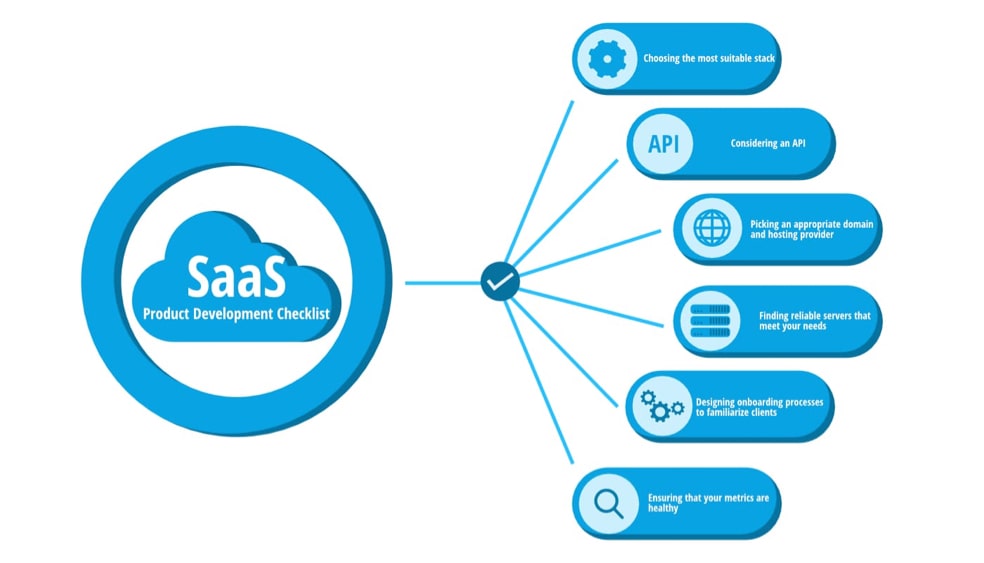Are you an ambitious entrepreneur creating your first SaaS product? Use this must-have SaaS development checklist to help you build a successful product and avoid the most common roadblocks.
Why do You Need a Checklist for SaaS Development?
As SaaS products become more popular, demand grows, and so does the competition. Many ambitious founders have made the mistake of recklessly diving into the fierce market without having a lean plan beforehand. A product development checklist outlines all the actions needed for smooth SaaS product development. If you want a leg up on the competition, consult this handy checklist so you don’t get overwhelmed or make any rookie mistakes.
What to Consider When Building a SaaS Product?
Choose a Tech Stack for Your SaaS
When you get down to SaaS application development, there is no shortage of tools as you might find plenty of paid and free options on the net . It can be easy to get confused about which stack to pick for your project. Take a look at some guidelines to help you choose:
- Project Scope. Some tech stacks are more suitable for startups and others for enterprises. Opt for something that will support your future growth.
- The Expertise of Your Software Engineering Team. Engineers have to be comfortable using the technology, as you will be running on a deadline. Some stacks have steeper learning curves than others.
- Time-to-market. If the project involves a lot of testing and development, there is a high chance you will not deliver the product on time.
- Maintainability. You will need developers to update the code as production goes on. Don’t choose anything too niche without a good reason.
- Budget. Determine how much you can spend. Some stacks require corporate bodies to purchase licenses or subscriptions, whereas others are open source and free to use.
Consider API Requirements
Another thing to consider during your SaaS product development is creating a useful API. A product with a public API has a competitive advantage. Customers will be able to easily customize and integrate the software with other tools they use. This makes your product much more appealing to a broader audience.
Domain and Hosting
If you’re doing SaaS web development, your URL is important. Often the domain name is the very first thing clients notice. If you want to stand out from the crowd, pick up the most “speaking” and memorable name your customers will remember
Many companies opt for the standard format of inserting the company name and then buying the .com domain, but there’s no harm in thinking outside the box. Recently, other domain name extensions such as .co, .io, and .net have become popular. Some are more suitable for SaaS software development companies than others. The .monster extension makes little sense, but .cloud is perfect for a SaaS business.
While you’re at it, weigh up your hosting provider options. Choose carefully, as most hosting plans don’t have the power and scalability needed for SaaS businesses. Many companies host their SaaS products on virtual private servers (VPS) or cloud plans.
Some reputable hosts include:
Server Side
The next step in the SaaS checklist is deciding which server will be most appropriate for your product. Explore the performance of different hosting providers. Many businesses have found that Amazon servers are the most cost-effective, offering decent performance, flexible options, and sufficient storage capacity.
Onboarding Processes
Regardless of whether the initial release of your product is simple or complex, you still need to help customers learn how to use your product. If you do this effectively, visitors are more likely to stick around and convert into paying customers.
Designing the onboarding processes should not be an afterthought. In many cases, it forms a user’s first impression. Carefully consider:
- Signup and signin options.
- Welcome or loading screens for your interface.
- An introductory tour of the software that explains the top features.
- Welcome and status emails.
- Video walkthroughs.
One of the main challenges in this regard is to consider your software from a fresh user’s perspective. If you’ve been developing it for months, you know how it works. You might take some knowledge for granted, whereas it wouldn’t be obvious to an external user. User testing can help here!
SaaS Operations
As soon as you’ve got an alpha or beta out, the focus of your SaaS checklist shifts to monitoring your SaaS operations. Consult your analytics team. Choose your KPIs before you launch anything, and make sure you have a system in place to track them carefully. How can you make sure your metrics are healthy? Monitor system-related activities such as privacy and security, server and application performance, and fault detection.
Make the Roadmap and the Deadlines Clear
Communication is crucial in SaaS product development. Strive to maintain constant communication with your team and other stakeholders to increase productivity. Everyone should be aware of the requirements and know when you’ll be launching the product privately, publicly, etc.
Put It All Together
To create a SaaS product that will succeed in the competitive market, go through all the tips above. Apply our advice before you start developing, so you don’t waste your time or money.

Conclusion
SaaS development is challenging, but profitable. However, if you follow the checklist outlined in this post, you’ll be gaining customers in no time. And we in LitsLink are always ready to help!
To summarize, every SaaS product development involves:
- Choosing the most suitable tech stack.
- Considering an API.
- Picking an appropriate domain and hosting provider.
- Finding reliable servers that meet your needs.
- Designing onboarding processes to familiarize clients.
- Ensuring that your metrics are healthy.